|
La Presa El
Cuchillo, Mexico
Story by Russ
Bassdozer
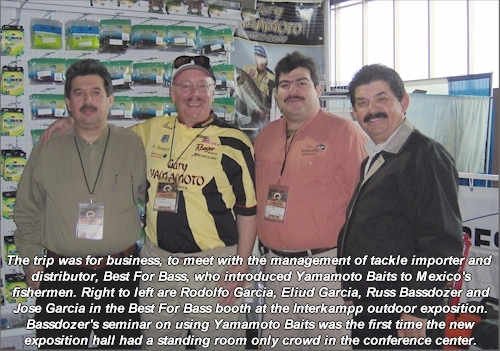 In
early February 2006, I visited La Presa El Cuchillo near the town
of China in northeast Mexico. "La presa" means
"the dam" in Spanish. Many of Mexico's trophy bass
waters are man-made impoundments. They're not called lakes in
Mexico. They're called dams. In
early February 2006, I visited La Presa El Cuchillo near the town
of China in northeast Mexico. "La presa" means
"the dam" in Spanish. Many of Mexico's trophy bass
waters are man-made impoundments. They're not called lakes in
Mexico. They're called dams.
It was a business trip to present
a Yamamoto fishing clinic to many avid anglers at Interkampp (www.interkampp.com),
an upscale outdoor exposition held in a brand new and beautiful
convention center in downtown Monterrey. I was invited to be the
guest of Rodolfo Garcia, a tackle importer and distributor.
Rodolfo's brother, Jose Garcia, and cousin, Eliud Garcia operate
the family business. The Garcias' two premier tackle shops, both
named "Best For Bass" are located in metropolitan
Monterrey. Through their company, Best for Bass, they have made
Gary Yamamoto Custom Baits a household name among anglers in
Mexico.
Monterrey, the city where the
exposition was held, is very interesting, very modern and
appeared affluent. It is as modern and bigger than many American
cities, and appeared more like a European or Mediterranean style
city nestled between the most beautiful and exotic mountains.
Four million people live in Monterrey, and it appears the
citizens in the sections of the city I saw are well-to-do and
sophisticated. They had the best of everything in the downtown
section - and as far as I could see during my brief stay,
Monterrey appears to be a stunning and modern city. |
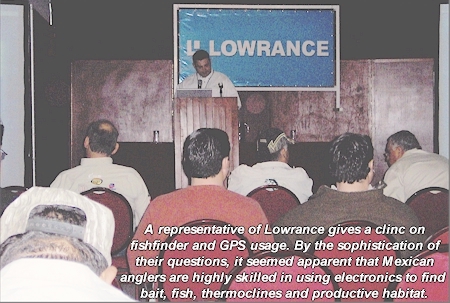 On
Saturday, I worked in the Best for Bass exhibit booth at the
outdoor exposition and gave a Yamamoto fishing clinic
presentation to a standing room only crowd of local Mexican
anglers. The Gary Yamamoto Fishing Clinic was packed. There were
no seats left in the audience. The convention center was built
about one year ago and there have been numerous conventions,
conferences and seminars of all kinds held there practically
every week. The Yamamoto fishing clinic was the first time the
seminar room was completely filled and standing room only.
Needless to say, the convention center management were very
impressed. The local anglers (and the fish) in Mexico just love
Gary Yamamoto Custom Baits! On
Saturday, I worked in the Best for Bass exhibit booth at the
outdoor exposition and gave a Yamamoto fishing clinic
presentation to a standing room only crowd of local Mexican
anglers. The Gary Yamamoto Fishing Clinic was packed. There were
no seats left in the audience. The convention center was built
about one year ago and there have been numerous conventions,
conferences and seminars of all kinds held there practically
every week. The Yamamoto fishing clinic was the first time the
seminar room was completely filled and standing room only.
Needless to say, the convention center management were very
impressed. The local anglers (and the fish) in Mexico just love
Gary Yamamoto Custom Baits!
On Friday, the day prior to the
clinic, I spent Friday fishing on La Presa El Cuchillo so I could
get some first-hand experience on the presa before giving the
fishing clinic on Saturday. Fishing was good - and of course, I
can't wait to return. One enchanting day on La Presa El Cuchillo,
Mexico's newest and hottest trophy bass lake, is not enough for
anyone.
|
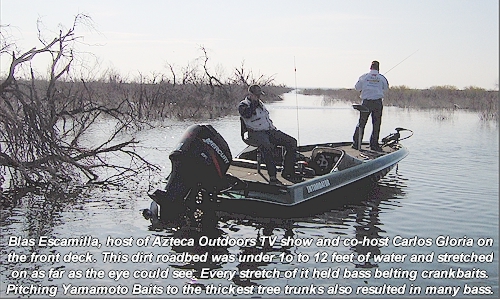 Blas
Escamilla, host of the "Azteca Outdoors" TV show and
co-host Carlos Gloria joined us on the fishing trip, and filmed
it for their TV show. Carlos owns MotoNautica which purchases,
sells, rents and repairs outdoor sports recreational vehicles
such as bass boats, fish and ski boats, wave runners, sea doos,
ATVs, motorcycles, light trucks, 4x4s and other vehicles for
hunting, fishing and outdoor recreation. Carlos is a fishing
guide on El Cuchillo and has the Hacienta Santa Fe Lodge on
nearby El Guerrero. So Carlos can guide fishing parties on two of
the best presas in Mexico, the world-famous trophy bass factory
El Guerrero and the still new and untapped big bass goldmine, El
Cuchillo. Blas
Escamilla, host of the "Azteca Outdoors" TV show and
co-host Carlos Gloria joined us on the fishing trip, and filmed
it for their TV show. Carlos owns MotoNautica which purchases,
sells, rents and repairs outdoor sports recreational vehicles
such as bass boats, fish and ski boats, wave runners, sea doos,
ATVs, motorcycles, light trucks, 4x4s and other vehicles for
hunting, fishing and outdoor recreation. Carlos is a fishing
guide on El Cuchillo and has the Hacienta Santa Fe Lodge on
nearby El Guerrero. So Carlos can guide fishing parties on two of
the best presas in Mexico, the world-famous trophy bass factory
El Guerrero and the still new and untapped big bass goldmine, El
Cuchillo.
Big bass waters abound across
Mexico. The majority are known only to the most adventurous
outdoorsmen. Many waters have only ever seen local fishermen.
Lake Huites. El Salto. Baccarac. Comedero. El Guerrero. These are
the select few and most famous spots where tourists travel on
pilgrimages to catch ten pound bass. Anglers from the United
States, Canada, Europe, Japan and fishermen from everywhere on
the planet journey to this famous handful of sparkling waters in
Mexico, to catch their bass of a lifetime. There are more double
digit bass caught in Mexico than anywhere.
The newest Mexican Mecca for
trophy bass is La Presa El Cuchillo. El Cuchillo is still
unfamiliar to the tourist fishing world at large, and still an
untapped goldmine of big bass. Opened to fishing in 1994, El
Cuchillo may be unique among Mexico's presas in that lucky local
residents, bass anglers numbering in the thousands fish El
Cuchillo passionately. Frequent bass tournament competitions with
over two hundred local bass boats are commonplace. The many
Mexican anglers who fish El Cuchillo have as new and modern bass
boats, the latest outboards and advanced electronics as anywhere.
|
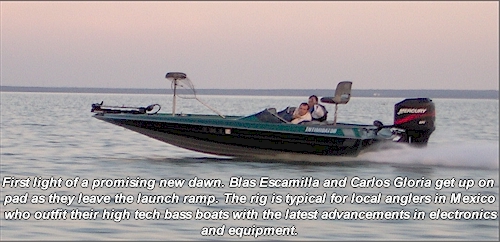 Upon
first arrival in the town of China, the first of many bass boats
I spied was a late model Triton as big as a battleship with a 300
horsepower engine towering handsomely over the transom. Truly an
impressive rig but not the only one. The latest bass boat models
were parked everywhere in town The driveways of many haciendas
were bristling with high-powered bass boats. It was instantly
clear that the anglers in this section of Mexico are as
up-to-date as bass anglers anywhere in the world. Upon
first arrival in the town of China, the first of many bass boats
I spied was a late model Triton as big as a battleship with a 300
horsepower engine towering handsomely over the transom. Truly an
impressive rig but not the only one. The latest bass boat models
were parked everywhere in town The driveways of many haciendas
were bristling with high-powered bass boats. It was instantly
clear that the anglers in this section of Mexico are as
up-to-date as bass anglers anywhere in the world.
Two hundred boat tournaments are
common - all Mexican local anglers - with the latest boats and
advanced electronics.
The local anglers who fish El
Cuchillo, their bass fishing skills, ability to strategize, make
decisions and understand bass are second to none.
Everyone is quite proud of the
bass fishing there, and the biologists and park officials take
the presa and the vitality of the bass fishery quite seriously.
|
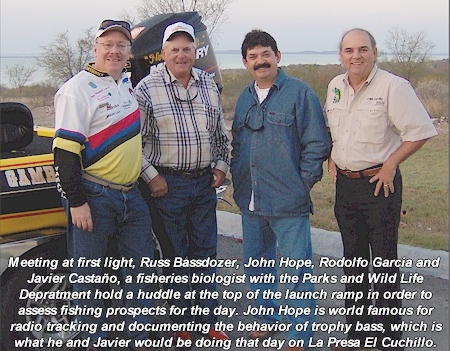 The
presa is in a state park and therefore does not permit commercial
fishing or netting. The
presa is in a state park and therefore does not permit commercial
fishing or netting.
For sportfishing, there is a limit
of one bass that can be kept per angler per day. Even still, most
passionate local bass anglers never keep a bass. For them, it is
voluntarily a catch-and-release presa.
The most prolific spawning grounds
are marked with buoys as off limits to fishing during spawning
season. I was there in early February, and it did not seem that
spawning had begun in earnest at that time. So I'd speculate that
March is when spawning may start to get into full swing on El
Cuchillo.
La Presa El Cuchillo, the dam is
at the northeast end and that's some 48 miles south of the
US-Mexican border. As part of developing this new Mecca for
sportfishing, El Cuchillo was heavily stocked with Florida bass
and anglers say the largemouth gene pool there is 54% Florida
strain. I didn't verify that. It is what local anglers proudly
told me about their beloved presa.
The other 46% of the bass genes in
El Cuchillo? Anglers say these are bass that were already there
in small presas that existed all along the original San Juan
River drainage and watershed. Local anglers reverently refer to
these as"Mexican bass" genes. Where these bass came
from to begin with or how long these bass have been in these
small presas in this part of Mexico, local anglers I met were not
sure.
In 1989, when the major dam was
first constructed to form El Cuchillo and hold back and impound
the waters of the San Juan River, the newly-forming impoundment
of El Cuchillo overflowed and flooded many numerous smaller
presas that had already been in the area for years. Some of the
original smaller earthen-dam presas, now flooded under, are known
to have been built thirty, forty or many more years ago. One map
I've seen showed about one dozen of these smaller bass-laden
presas. Click here to view an El
Cuchillo map page.
|
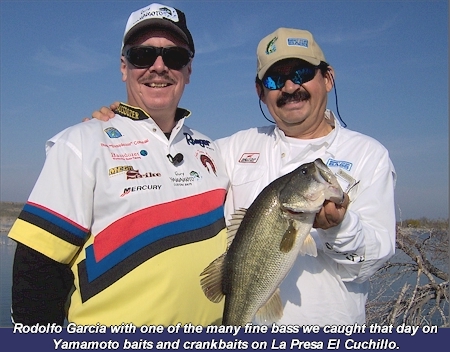 These
original smaller presas are now completely under or broken
through and adjoined along the shoreline of El Cuchillo. These
original presas are where the other 46% of the bass genes in El
Cuchillo are said to come from. I did not verify this, but it is
part of the local angling folklore. These
original smaller presas are now completely under or broken
through and adjoined along the shoreline of El Cuchillo. These
original presas are where the other 46% of the bass genes in El
Cuchillo are said to come from. I did not verify this, but it is
part of the local angling folklore.
Although underwater or with their
earthen dams broken through and overflown by El Cuchillo, the
original smaller presas are still peak mega-centers of bass
activity. Bass still seem to exist and live in these underwater
or broken-through smaller presas as if they were not part of the
bigger presa. Fishing the locations of the original presas,
whether adjoined along the shoreline or submerged mid-lake under
twenty feet of water, that is the primary key to success on El
Cuchillo as I see it in my one day of fishing there. This is an
overlooked and little-known concept on any man-made impoundment -
to strictly fish the original water and drainage systems that
were present before the impoundment. It can be successful, and
all you ever need to do on man-made impoundments.
That not only means the original
smaller presa, but includes, equally importantly, any original
streams, riverbeds or drainages or washes or gulches that are now
underwater. Some of these can still be seen above land along the
shoreline as inflowing creeks or streams or seeps still flowing,
either year-round, intermittent seasonally or downpour
incident-driven flowage veins. But many can really only be
discovered by studying old maps and then pinpointing them with
sonar and GPS electronics. Ferreting out as many maps from as
many sources as possible are part of this process, since no two
maps show the same original watershed features. If you're serious
about mastering El Cuchillo (or any man-made impoundment), you
have just been handed the key to unlock some fantastic fishing.
In addition to the original
smaller presas and original watershed system and drainage run-off
routes, any flooded roadbeds, whether dirt roads or pavement, and
any flooded man-made buildings, clear-cut brush perimeters and so
on are also key. These are some of the best places to fish for
the bass of a lifetime on La Presa El Cuchillo. Especially where
one or more of these features converge or intersect. If you
maximize your time spent at these types of locations, you should
do swell any time of the season in my opinion. A couple of the
longer roadbeds we fished, it seemed we could have stayed on
those road beds catching bass all day. However, we left while the
fish were still biting so that I could get a feel for other spots
on the lake.
|
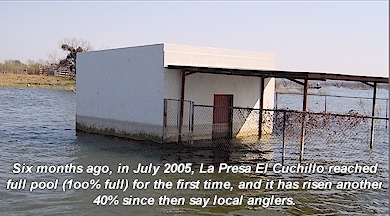 In
terms of size, by crisscrossing it by boat several times during
the day, I would say the main basin appears to be about 10 to 12
miles long and 3 to 4 miles across at most places at the current
water level. In
terms of size, by crisscrossing it by boat several times during
the day, I would say the main basin appears to be about 10 to 12
miles long and 3 to 4 miles across at most places at the current
water level.
True, this is a big basin, but it
is not a huge body of water. Thanks to the guiding of world-class
angler Carlos Gloria, I was able to dissect and fish all four
quadrants of the main basin of El Cuchillo in one day. I sampled
a diversity of productive cover and structure, and felt I was
able to gain a deep understanding of the presa and how to fish
it.
El Cuchillo is currently well over
full pool. The dam was built in 1989. When opened to fishing in
1994, El Cuchillo was about 17% full and it weathered a period of
subsequent dry years so it did not fill quickly. About six months
ago, it first reached 100% full, and it has increased in size by
40% over full pool within the past six months due to the major
hurricanes in August and September 2005. This article is
information I pieced together from a brief trip, and it may not
necessarily be correct or complete.
Most of the fish were found
holding in 10 to 15 feet of water this day. This seems to me will
probably always hold up as a reliable depth to find fish on La
Presa El Cuchillo. If you focus your fishing in this depth range,
you should have a good chance to do well any time of the season
in my opinion. It's just a good, stable depth of water, and a
transitional zone between shallower and deeper areas. This depth
of water was mostly buffered and sheltered from El Cuchillo's
often powerful winds. Outside brush and tree lines in deeper
water bore the brunt of the wind, but sheltered the 10 to 15 foot
depths which were often calmer and clearer.
However, don't neglect the exposed
outer structure if wind permits. On the deeper outside brush and
tree lines, offshore ledges and drop-offs of main lake points, we
caught fish as deep as 20 feet. Main lake points, emergent
mid-lake islands, ledges and drop-offs all held fish this day. I
feel these types of more exposed main lake areas will probably
always be good prospects on any day here, depending on whether
the wind lets you fish these exposed outside areas. One of the
smaller sunken presas we fished, it seemed to be way out in the
middle of nowhere under 20 feet of water, yet still laden with
hefty bass as if they never left the smaller sunken presa. If you
concentrate your fishing on these types of locations, you should
be able to find action any time of the season, wind permitting,
in my opinion. |
 There
is also the San Juan River arm which enters the main basin from
the south end. The navigable length and nature of this inflowing
water source, I do not know and did not see. The river arm
extends for some distance, and many of the locals like Carlos
Gloria know the river arm like the back of his hand. According to
Carlos, you would need weeks to fish it all. There are many good
points to fish, there are long arms with creeks and underwater
caverns, trees, cliffs, and small side rivers (four of them) full
of big dead trees. The main river channel is 40 to 50 feet deep
while the main basin is over 70 feet deep. There
is also the San Juan River arm which enters the main basin from
the south end. The navigable length and nature of this inflowing
water source, I do not know and did not see. The river arm
extends for some distance, and many of the locals like Carlos
Gloria know the river arm like the back of his hand. According to
Carlos, you would need weeks to fish it all. There are many good
points to fish, there are long arms with creeks and underwater
caverns, trees, cliffs, and small side rivers (four of them) full
of big dead trees. The main river channel is 40 to 50 feet deep
while the main basin is over 70 feet deep.
The river arm is said to have a
crawdad population and good bass fishing. Yet the main body of
the presa is said to not have many crawfish. But it more than
makes up for the perceived lack of crawfish by having a
plentitude of finned baitfish. The presa teems with countless
schools of silversides, tilapia, bluegill sunfish, gizzard shad,
threadfin shad and several other small baitfish species common to
the region. In addition to largemouth bass, there are gar,
bowfin, carp and catfish.
My guide to El Cuchillo, Carlos
Garcia is clearly a world class angler in my opinion, and
apparently one of the best anglers in the state of Nuevo Leon,
Mexico. That was my impression which I base on his proven track
record of scoring highly in tournament competition. With Carlos
picking our fishing spots and making the decisions when to move
where, we caught many bass, primarily two to four pounds - some
bigger, some smaller - all day at every stop we made. Bass were
plentiful and everywhere Carlos took us, we scored well. |
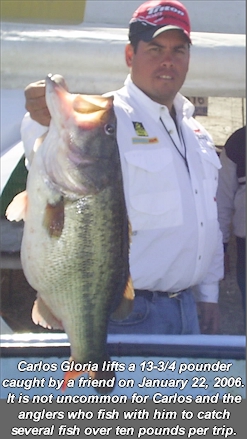 In
thick brush and tree cover, the Yamamoto Senko, the 13-series
Yamamoto lizard, the 7X-series Yamamoto Kut Tail Worm and the
Yamamoto Kreature were all equally productive. Oh yes, the
10-series Yamamoto Big Grub worked as well as anything else, and
the Big Grub is the numero uno preferred big bass bait of many El
Cuchillo anglers. In
thick brush and tree cover, the Yamamoto Senko, the 13-series
Yamamoto lizard, the 7X-series Yamamoto Kut Tail Worm and the
Yamamoto Kreature were all equally productive. Oh yes, the
10-series Yamamoto Big Grub worked as well as anything else, and
the Big Grub is the numero uno preferred big bass bait of many El
Cuchillo anglers.
Flipping jigs are not used much
because of the perception that the dense brush, believe it or
not, is too thick to fish even the most snagless of jigs.
Therefore, flipping and pitching Texas-rigged soft plastics with
screw-in bullet weights is the most popular and most snagless
fishing tactic day in and day out on El Cuchillo.
Crankbaits also caught a lot of
bass in open water over the road beds or where brush and trees
were sparse enough to make a cast without hanging up. A variety
of medium to deep-running crankbaits worked, say anything that
would get down to six feet or as deep as ten feet.
There is a sign in the airport at
Monterrey that greets visitors. It says, "If you don't like
the weather, come back in one hour." This saying describes
the strong and powerful winds that rise and fall suddenly in this
region. On El Cuchillo, most local anglers have marine radios.
Anglers say that park officials tend to ask if you have a radio
onboard when you enter the park, and the officials broadcast
sudden wind alerts. Winds can be sudden, strong and dangerous to
boaters. Wind alerts are broadcast in Spanish only. If you are
fishing on your own, you need to be prepared for strong winds and
rough water. It can get pretty sporting in an instant.
Because of the constant ebb and
flow of wind throughout the day, screw-in sinkers are pretty much
standard fare for flipping and pitching soft plastics. When the
wind is quiet, weightless soft plastics can be used, but most of
the time, a screw-in sinker is required to fish soft baits in the
wind. A good all-around size is 3/8 ounce for fishing 10 to 15
foot depths. When the wind is down, you can go lighter, and when
it howls, you may need to go as heavy as one ounce in order to
fish effectively. However, if you want to stick with just one
size as an all-around compromise, I'd say 3/8 or 1/2 ounce will
work under a range of wind conditions.
I didn't see any gin clear water
on El Cuchillo, and the depth range that held the most fish, from
10 to 15 feet deep, seemed to be the clearest band of water,
although still stained. Shallower than that, the water soured,
got thicker and more stained, whereas deeper than that, the water
was less protected from the wind, and therefore also more stained
as far as I saw that day. The band of water in the middle - from
10 to 15 feet - seemed to be the freshest, least stained section,
and also held the most fish that day. There are certainly periods
when local anglers catch many fish much shallower, but during my
visit, the shallower water was dirtier and presumably less
oxygenated than the ten to fifteen foot deep band of clearer,
fresher water.
Although fishfinders can be set to
display either meters or feet, the custom of local anglers on El
Cuchillo is to set their fishfinders to display depth in feet.
Everything else, however, speed, distance, length and weight is
the metric system (and Spanish language). The magic mark for
double-digit bass (ten pounders) is 4.55 kilograms. Kilograms are
the easiest metric unit to convert (to pounds) and the most
important number to anglers - 4.55 kilos. Simply multiply
kilograms by 2.2 to convert to pounds - and keep your fingers
crossed that the metric scales of the big bass you catch on La
Presa El Cuchillo exceeds 4.55 kilos (times 2.2 = 10.01 pounds).
That is the magic mark that is achievable any day when you fish
El Cuchillo!
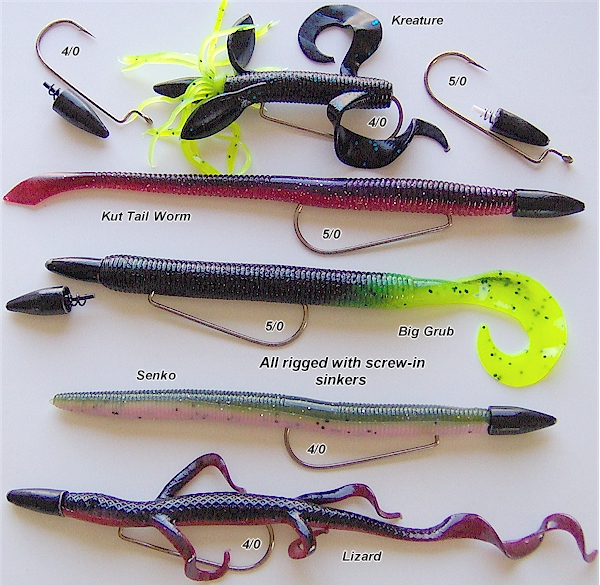
|
| If
You Go ~ WHO TO CONTACT |
| Tackle Shop: |
BEST FOR BASS |
| Proprietor: |
Eliud Garcia |
Phone:
Fax:
Email: |
(011) 52 + (81) 83700505
(011) 52 + (81) 83734007
best_for_bass@hotmail.com |
| Location: |
Raul Rangel Frias
#550 Col. Burocratas
Monterrey, Nuevo Leon Mexico C.P. 64380 |
|
|
|
| Equipment
Checklist ~ WHAT TO TRY |
| Pitching &
Flipping Rod: |
Falcon Expert Model #EC-7H or
comparable seven foot heavy action rod |
| Reel: |
Shimano Castaic, Daiwa
TD-103 series or comparable heavy duty baitcaster |
| Line: |
Power Pro 65 lb test braid
(No leader required. Tie direct) |
| Sinkers: |
Bullet Weights Screw-in
weights ~ assorted sizes from light to heavy |
| Hooks: |
Gamakatsu or Daiichi 4/0
(minimum) or 5/0 (preferred)
90-degree offset round bend wide gap heavy wire |
| Soft Plastics: |
Yamamoto Senko 9-series
Yamamoto Big Grub 10-series
Yamamoto Lizard 13-series
Yamamoto Kut Tail Worm 7X-series
Yamamoto Kreature 5-series |
| Colors: |
066 Black with chartreuse tail
908 Rainbow trout laminate (watermelon/bubblegum)
522 Black with chartreuse skirt
900 Red shad laminate
922 Red shad with silver laminate
913 Green pumpkin with chartreuse tip
297 Green pumpkin pepper
330 Green pumpkin with purple & copper
520 Black with blue tail
523 Black with blue tip |
|
| Crankbait Rod: |
Seven foot Falcon Cara
CCB-4-17MR Deep Cranker I |
| Reel: |
Shimano Chronarch B or
comparable high-strength baitcaster |
| Line: |
Yamamoto Sugoi Fluorocarbon
~ gray casting line ~ 12 to 14 lb test |
| Crankbaits: |
Your favorite medium (6 foot
range) and deep-running (10 foot range) crankbaits |
|
|
|
